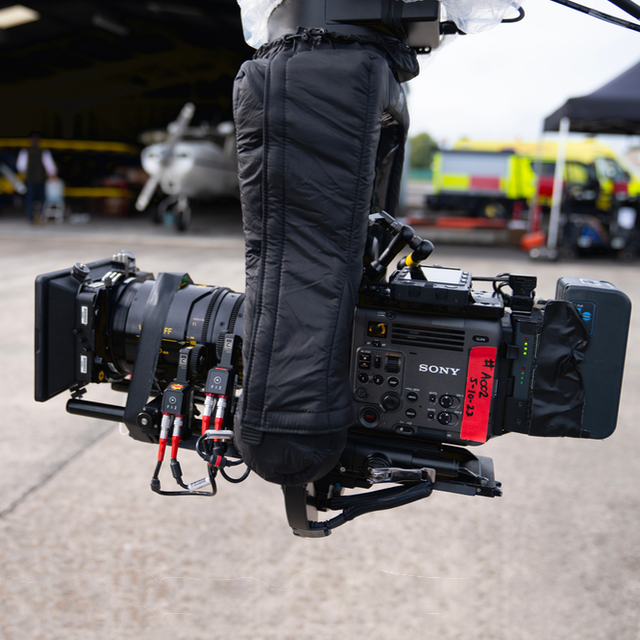Full-Frame

What is Full-Frame?
A full-frame sensor is most simply defined by its sheer size – 36mm by 24mm – and the distinctive look it makes possible. Compared to a Super 35mm sensor, a full-frame sensor has over twice the surface area while providing a wider angle of view and shallower depth of field.
Full-frame sensors are by far the largest image sensors in general use today and are widely regarded as the pinnacle of digital cinematography – due both to the inherent advantages of full-frame itself and a wide array of cutting-edge supporting technologies.

Limitless possibilities with full-frame: experience wonderful imagery shot on FX9 and VENICE
Full-Frame Heritage
The physical dimensions of a full-frame sensor date back to the early 1900s when 35mm film emerged as a universal standard for filmmaking and, later,as 135 film for stills photography. In traditional movie-making, film travels vertically through the camera, providing a variety of different image formats.
One of them, 3 Perf, uses just 3 perforations in the film per frame equating to an individual widescreen frame of 24.89mm x 14mm, commonly referred to as Super 35mm. For stills photography, film travels horizontally through the camera providing the largest of all the popular image formats for 35mm film, with a 36mm by 24mm frame, using 8 perforations on the film for each frame, traditionally called Full-Frame.
At the turn of the 21st century, digital cameras with Super35 size sensors (including Sony’s revolutionary F35) proved good enough to challenge film cameras and started the digital revolution in Hollywood and across the world. For the next generation of filmmaking cameras, however, manufacturers began to think bigger than Super 35. A lot bigger.

Acclaimed filmmaker Alister Chapman explores the creative benefits of shooting with full-frame
Benefits of Full-Frame Sensors
Full-Frame copies the frame size from 35mm film stills cameras, allowing the same lenses and lens mounts from older film cameras to be used in new digital stills cameras, with the same look and feel, principles of photography, framing, focus and depth of field. It also allows for backwards compatibility with Super 35 and other formats.
Wider Field of View
Since a full-frame sensor is bigger than a Super 35mm sensor, it naturally captures a wider image. Shooting from the same position with the same lens, a full-frame camera allows you to see more of the scene which can be helpful in certain situations. The below images help illustrate this.

Full-Frame (16:9)

Super 35mm (16:9)
Creative depth of field
Full-frame sensors offer the opportunity of narrow depth of field by maximising the creative possibilities of large aperture lenses. By using both a lens with a large maximum aperture, and a full-frame sensor, it is easy to achieve a very narrow depth of field in the image. A narrow depth of field means particular objects in the scene can be picked out, pushing everything in front and behind out of focus. Audiences can be subliminally directed to look at certain objects in the scene as part of the screen play or story-telling process.

Shallow depth of field

Wide depth of field
Format Flexibility thanks to Full-Frame
The use of a full frame sized sensor, in particular one with 6K of pixels allows the camera to support many different shooting formats by selecting different scan areas. A 6K full frame sensor can provide a native 4K super 35mm as well as a multitude of anamorphic modes*1 including 35mm open gate. This means that with one sensor you can choose whether to shoot with dedicated full frame lenses, traditional super 35mm cine lenses or anamorphic lenses. When using 4K super 35mm scan the camera will perform without compromise compared to any other conventional 4K super 35mm camera. Sony’s Venice camera supports a particularly large range of user selectable imager modes and aspect ratios. The FX9’s also supports a 2K super 16mm scan mode*2.
*1 V3.0 firmware will support view finder de-squeeze and frame line display for anamorphic lens
*2 V3.0 firmware will support a 2K super 16mm scan mode.

High resolution for superb clarity and oversampling
Since a Full-Frame sensor is bigger, this can mean higher resolution (with more photosites) or increased sensitivity (with larger photosites) or as is usually the case: a careful mix of both. High resolution can also be used for oversampling where the sensor captures more pixels than required in the final image, but uses advanced image processing in the camera to boost clarity and retain fine detail that might otherwise be lost with a smaller sensor with less resolution.
Photosites for various sensors with similar resolutions

Highly detailed image reproduction by starting with 6K of bayer pixels

Images from left: Bayered Pattern Layout, Bayered Pattern Process, Full Colour De-Bayered Image.
Full Frame oversampling for stunning 4K, UHD and HD images
Aliasing Noise is generated when the frequency component contained in the input signal is higher than ½ of the sampling frequency (Nyquist frequency) in the process of signal sampling. When the resolution is lowered, Aliasing Noise tends to occur. By shooting 4K with a 6K full-frame sensor, Aliasing Noise is reduced and imagery is sharper and cleaner.

Unrivalled lens choice
A full-frame sensor gives you the ability to use a huge range of Full Frame, Super 35mm, Photo and Cine lenses.

Full-Frame & New Technology
In addition to all the inherent benefits of full-frame sensors, there are additional technologies that can further enhance real world performance and creative flexibility.
Dynamic Range & Exmor R
Dynamic range is normally measured in stops, a measure of the aperture or iris in the lens. A better sensor is able to differentiate more stop levels of grey between black and white. For instance, the human eye has a dynamic range of about 10-15 stops.
Full-Frame sensors can provide enhanced dynamic range with a relaxed design space and larger photosites. Sony’s Exmor R sensor, adopted by FX9 extends this benefit by radically realigning the pixel structure as shown below. Consequently, Sony Full-Frame sensors can achieve dynamic ranges equal to, or even exceeding what the human eye can capture.

“Exmor” CMOS sensor
Conventional front-illuminated sensor as used in FS7II

“Exmor R” CMOS sensor
Dual Base ISO
Digital imaging sensors perform best when set to their base ISO. It’s at this base ISO value you will achieve the optimum balance of low noise, the best signal to noise ratio, and almost always, the widest possible dynamic range. This is because at the base ISO setting, there is no amplification, or gain (voltage), added to the signal coming from the sensor. Adding gain to increase the ISO, or to make the image appear brighter adds noise and in most cases will reduce the dynamic range that can be recorded. Increase the gain to make an image appear twice as bright and you’re also introducing twice as much noise to the signal and the image quality is thusly decreased. While grain on analog film, like at ASA 400 for example, might be pleasing and enhance the feel of an image, the introduction of digital noise to an image rarely brings a similarly pleasing result.
To help avoid this, the VENICE and FX9 camera’s full frame sensor has what is termed Dual Base ISO. Dual Base ISO means the camera’s imaging sensor has two distinct sensitivities to light. At each ISO there is very little difference in image quality. Dynamic range and colour are almost identical and noise is not significantly different.
VENICE has a base ISO of 500 to provide the optimal dynamic range for applications where on-set lighting is standard. A secondary High Base ISO of 2500 excels in low-light High Dynamic Range capture. FX9 features a base sensitivity of ISO 800, providing the optimal dynamic range for applications such as shooting outside or in brightly lit interiors. A secondary High Base sensitivity of ISO 4000 excels in low light scenarios. You simply use the base ISO most appropriate for your light levels without any significant change in image quality or any need to change your workflow.


Low Base ISO

High Base ISO
Creative use of the electronic variable ND filter with Full-Frame
FX9 is the world’s first full-frame camcorder with an electronic ND (neutral density) filter which, at its simplest, removes the need for manually fitting and changing fixed filters. This is no small benefit, but by combining a Full-Frame with a large aperture auto-iris lens, and an electronic ND filter, it is possible to create scenes that change in ways never seen before. Alter the ND filter during the shot and the iris will automatically adjust to maintain good exposure, thus changing the depth of field as the scene progresses. If the lens is not an auto-iris type, no problem! Simply switch the electronic ND filter to auto, and adjust the iris during the shot to create the same effect. Take a look at the Electronic ND Filter Tech Guide for more information on how to use the electronic ND filter.
Sony advanced Full-Frame auto-focussing
The shallow depth of field which is so distinctive for full-frame cameras also creates a challenge for the camera operator in maintaining such a precise focus. For a high-end cinematography camera like VENICE, it’s traditional for a focus puller to manually maintain this focus. In other, non-scripted applications like documentaries or news, this isn’t practical.
Camera operators traditionally look down upon autofocus systems as insufficiently accurate and restrictive of their creative flexibility. However, with FX9, Sony implemented an advanced autofocus system never before seen on a full-frame professional camcorder. Its precision allows for exceptionally shallow depth of field, while also supporting a wide range of creative options in terms of speed and tracking. So rather than restricting an operator’s creative options, it provides a tool for additional creativity and makes full-frame’s shallow depth of field practical for almost any given scenario, from slow-moving period drama through to high-speed sports.
Full-Frame Professional Cameras from Sony
CineAlta Cameras
Next generation cinematography cameras with phenomenal colour science, user-friendly operation and a choice of 8K and 6K full frame sensors. Dual Base ISO and 8-step internal ND filter system provide exceptional shooting flexibility with VENICE 2, while the compact BURANO is easily configurable for solo and team production.


PXW-FX9
The FX9 features a full-frame 6K sensor with high quality recording in DCI 4K*, Ultra HD and HD resolutions. Powerful image processing with debayering and oversampling ensures image quality beyond the limits of conventional Super 35mm sensors. It is the world’s first full-frame camcorder with electronic variable ND, Fast Hybrid AF and has Dual Base ISO 800 / ISO 4000.
*DCI 4K (4096 x 2160 at 17:9 recording) requires Ver.2.0 or higher firmware.
FX6
The ILME-FX6 leverages technology from Sony’s industry-leading VENICE cinema camera and marries it with the best of Sony’s innovative Alpha mirrorless camera technology. It features a 10.2 MP full-frame back-illuminated Exmor R™ CMOS sensor that delivers a 15+ stop wide dynamic range with high sensitivity and low noise. Leveraging the colour science of VENICE, FX6 also allows productions to easily match footage with other cameras in the Cinema Line.


FX3
The ILME-FX3 leverages technology from Sony’s industry-leading VENICE cinema camera and marries it with the best of Sony’s innovative Alpha mirrorless camera technology. It features a 10.2 MP full-frame back-illuminated Exmor R™ CMOS sensor that delivers a 15+ stop wide dynamic range with high sensitivity and low noise. Leveraging the colour science of VENICE, FX6 also allows productions to easily match footage with other cameras in the Cinema Line.
FR7: Full-frame PTZ Interchangeable-lens camera
The FR7 is a full-frame cinematic PTZ camera with a range of advanced features, including the ability to capture Log footage and record 4K on-board. Its built-in variable ND filters and face-tracking autofocus ensure high-quality footage, while its S-Cinetone™ color science provides a cinematic look. Ideal for live events, reality TV, and corporate settings, the FR7 is a versatile and efficient tool for capturing high-quality video content.






